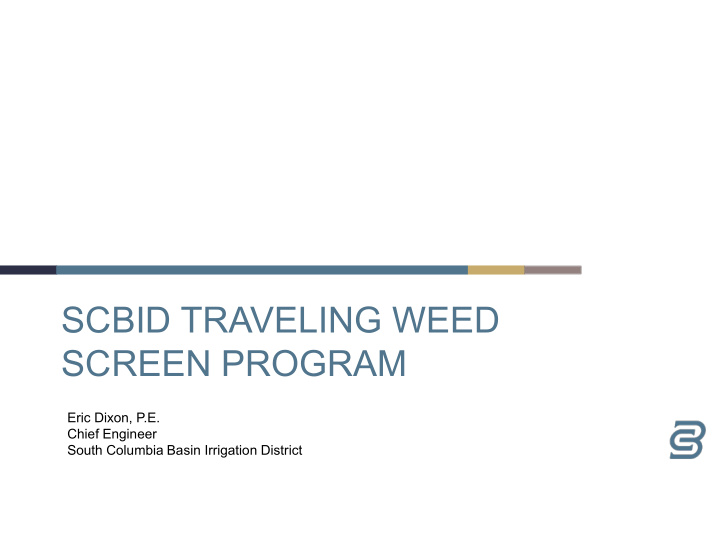



SCBID TRAVELING WEED SCREEN PROGRAM Eric Dixon, P.E. Chief Engineer South Columbia Basin Irrigation District
OVERVIEW A look at the weed problem – Primarily in the context of pumping plants Some common approaches to handling weeds/debris SCBID traveling weed screen program Results ** Primary focus is on techniques/methods used by SCBID
THE PROBLEM… Weeds, more weeds, and some other stuff – Weeds: aquatic, terrestrial – Other stuff: crops, garbage, general debris
THE PROBLEM CONT.
THE PROBLEM CONT. Sometimes the Debris is really big!! Public Safety Announcement: Don’t text will tractoring…
THE PROBLEM CONT. So what happens??? – Intake racks blocked – pumps shut down • Service interruptions • Canal/Ditch fluctuations upstream and downstream • Racks must be cleaned & pumps restarted
SCREENING/HANDLING Two approaches (not going to talk about weed treatment/prevention programs) – Manual Labor – Mechanical
SCREENING/HANDLING CONT. Manual Labor – Use of rakes/hand tools by employees – Labor intensive/time consuming – After hours call-outs and overtime – Safety hazards • Night work near water • Physical strain
SCREENING/HANDLING CONT. Mechanical – Various methods • Automated rakers (various types) • Rotating drum screens • Passive screens • Traveling screens • Use of heavy equipment: excavators, etc. – All three Districts in CBP using some or all of these mechanical methods.
SCREENING/HANDLING CONT. Mechanical – Automated Raker
SCREENING/HANDLING CONT. Traveling Screens – Simple design concept – Typical installations • Move material in a downstream direction • Require structural work in channel • Require space downstream for material deposit
SCREENING/HANDLING CONT. Traveling Screens Cont.
SCBID TRAVELING SCREEN PROGRAM We are a little backwards down South – Standard traveling screen concept but run them against the flow
SCBID TRAVELING SCREEN PROGRAM Why??? – No structural work required in the channel with one exception – Minimal modifications required to pumping plant structure – Material is deposited upstream away from the pumping plant for better access/cleanliness – Some redundancy is maintained with remaining bar racks
SCBID TRAVELING SCREEN PROGRAM The Prototype – Constructed in-house winter 2015 – 28 CFS (12,600 GPM) pumping plant
SCBID TRAVELING SCREEN PROGRAM The Basics – Box sits on P.P. apron – screen sits on box – Existing bar rack removed at box outlet – Flow over screen through box
SCBID TRAVELING SCREEN PROGRAM The Basics Cont. – Epoxy coated frame and box – Polymer screen material – No moving parts under water – Small ½ HP drive motor with timer/manual control
SCBID TRAVELING SCREEN PROGRAM Results – Very quick in-field installation time – Extremely reliable – Little to no maintenance – No fouling of polymer screen material • Spray bars not required – No pumping plant failures due to weeds/debris
SCBID TRAVELING SCREEN PROGRAM Results Cont. – Example: 2019 Installation • EB1 PP: 75 CFS (33,700 GPM) • Typically offline 20-25 times due to weeds/debris • This year no plant failures due to weeds/debris
CONCLUSION SCBID on 5 th year of program – Exceeded expectations – In-house construction allows us to: control costs, implement unique configurations Weed/debris handling remains a continual problem for all CBP Districts. Various Methods, One Goal: – Deliver water to our landowners • Safely • Reliably • Efficiently
ANY QUESTIONS? Eric Dixon, P.E. Chief Engineer South Columbia Basin Irrigation District Edixon@scbid.org 509-547-1735
Recommend
More recommend